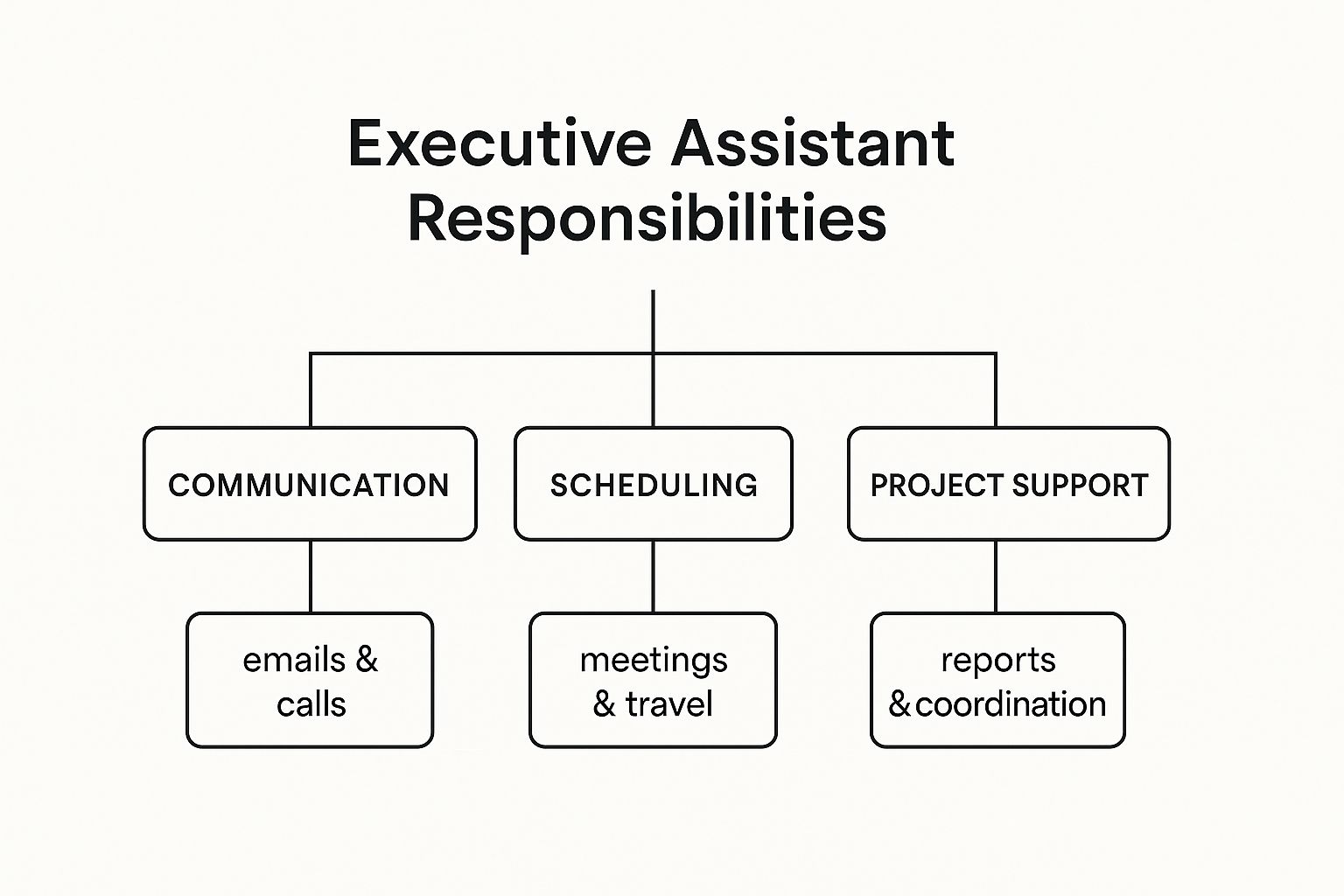An executive assistant position description is so much more than just another recruitment document. It is your first, and arguably most important, strategic communication with a potential high-calibre business partner. Think of it as a detailed blueprint for a crucial professional relationship, one that sets the stage for success right from the very beginning.
Why Your Executive Assistant Position Description Matters

Getting the executive assistant position description right is one of the most critical steps in the hiring process, yet it is something I see rushed all too often. You need to treat it as your primary marketing tool for attracting a genuine strategic partner, not just an employee. A vague description will only bring in generic applications, which is a massive drain on your time and resources.
On the other hand, a well-defined, thoughtful document acts as a powerful filter. It draws in professionals who are a genuine match for what your executive and your company actually need.
This document is effectively the first handshake between your organisation and a potential candidate. It needs to communicate the true scope and impact of the role, moving beyond a simple to-do list to show how this person will be vital to the leadership team's success. It is your chance to put your company culture on display and give a real sense of the executive's working style.
Setting Expectations and Attracting the Right Talent
A crystal-clear description sets realistic expectations from day one, which is absolutely vital for long-term retention. When a candidate fully grasps the complexities and demands of the role before they even apply, you avoid many potential misunderstandings down the track. This kind of transparency builds immediate trust and makes sure the person who joins your team is ready and motivated from the get-go.
A compelling description should achieve a few key goals:
- Attract High-Calibre Professionals: The best EAs are searching for roles where they can make a real, significant impact. Your description needs to shout this from the rooftops.
- Filter Unsuitable Applicants: By being incredibly specific about the required skills, responsibilities, and cultural fit, you naturally weed out those who just are not right for the job.
- Save Time and Resources: A stronger, more relevant applicant pool means a far more efficient interview process and a much higher chance of getting the hire right the first time.
A thoughtfully written executive assistant position description is not just an administrative task; it is a strategic investment in your executive's productivity and your company's operational excellence.
Ultimately, this document is your single best tool for finding an assistant who can anticipate needs, juggle complex priorities, and act as a true extension of the executive. It is not about finding someone to manage a calendar; it is about finding someone who will help you manage the business.
The Anatomy of a Compelling EA Position Description
To attract the best talent, your executive assistant position description needs a solid framework. Think of it as a blueprint for success; each part has a specific job to do, guiding the right people towards your company while politely showing those who are not a good fit that this is not the role for them. A well-constructed description is clear, thorough, and easy for a busy professional to scan.
The structure of a great job advertisement is quite straightforward, but every piece is strategic. It kicks off with a clear job title and a summary that grabs attention, before diving into the nitty-gritty of responsibilities and qualifications. Each section logically flows into the next, building a complete picture and leaving no room for confusion. This methodical approach ensures you cover all the important bases.
Core Structural Elements
The foundational parts of your description work together to paint a clear picture of what the role truly involves. Your summary should be like a great sales pitch – it needs to capture the essence of the opportunity and highlight what makes your organisation a fantastic place to work. Then, the responsibilities section needs to be all about action, using strong verbs to show candidates exactly how they will be making a real impact on the executive's success.
The following image breaks down an executive assistant's main duties into three key pillars.

As you can see, communication, scheduling, and project support really are the central nervous system of the EA role. Each function is deeply connected, demanding a professional who can juggle different—and often competing—priorities without breaking a sweat.
Building a Comprehensive Framework
Beyond the day-to-day duties, the qualifications and skills section is where you get to sketch out your ideal candidate. This is your chance to be upfront about the must-haves, such as being a wizard with certain software, as well as the nice-to-haves, such as previous industry experience. Spelling these out helps candidates honestly self-assess whether they are the right fit, which ultimately means you get a stronger pool of applicants.
Before we dive deeper, here is a quick summary of the essential components and why they matter.
Essential Components for Your EA Position Description
| Component | Purpose and Key Information |
|---|---|
| Role Summary | This is your hook. It should briefly explain the role's purpose, the executive it supports, and what makes the opportunity exciting. |
| Responsibilities | Use a bulleted list with action verbs to detail the core duties. Think calendar management, travel coordination, and meeting preparation. |
| Qualifications | List the non-negotiables. This includes required years of experience, educational background, and any essential certifications. |
| Skills | Outline the key hard and soft skills needed for success, such as proficiency in Microsoft Office, communication skills, and problem-solving abilities. |
Getting these sections right turns a simple job listing into a powerful recruitment tool. By carefully crafting each part of the executive assistant position description, you are creating an asset that works for you. For more tips on this, our guide on how to create job ads that attract the right candidates has plenty of extra strategies to help you sharpen your approach. A well-built description does not just list tasks; it shows how vital the role is to the bigger picture.
An effective executive assistant position description is a narrative that connects daily tasks to broader business objectives. It tells a story about impact, partnership, and professional growth, making it irresistible to top-tier talent who are looking for more than just a job.
Ultimately, your goal is to explain not just what the EA will do, but why their contribution is so important. This strategic approach transforms a standard job advertisement into a compelling invitation, making sure you connect with professionals who have the drive and skill to become a true partner to your leadership team. Getting this clarity right from the start lays the groundwork for a successful, long-term working relationship.
Defining Responsibilities with Clarity and Impact

This section is the absolute heart of your job description. It is where you need to paint a clear and compelling picture of what the day-to-day reality of the role looks like. We need to move beyond generic, copy-pasted phrases and spell out the duties with real precision and purpose. This is your chance to show candidates just how vital their contribution will be.
Instead of just dumping a long list of tasks, try grouping responsibilities into core functions. This helps applicants see the main pillars of the job and figure out how their own skills match up with your executive's needs. Think of it less like a dry job specification and more like a mission briefing.
Strategic Calendar and Meeting Management
Let us be clear: this is about so much more than just booking appointments. A top-tier EA is a strategic manager of their executive's time—their most valuable and limited resource. It involves actively protecting their focus time, prioritising meetings based on what is actually important for the business, and making sure the executive walks into every single interaction perfectly prepared.
To capture this, use dynamic language that shows you are looking for a proactive partner:
- Strategically manage the executive's calendar, aligning appointments with key business priorities to ensure an optimal workflow.
- Prepare and circulate detailed agendas, briefing materials, and presentations well ahead of key meetings.
- Anticipate and resolve scheduling conflicts with diplomacy and foresight before they become problems.
- Coordinate all meeting logistics, from booking rooms and setting up technology to organising catering and communicating with attendees.
Proactive Communication and Information Flow
A great EA acts as a crucial communication hub. They are the gatekeeper to the executive’s attention, but they also ensure that critical information flows exactly where it needs to go, without friction. They become a trusted voice, representing the executive with complete professionalism and tact. This is not just about answering emails; it is about being a reliable conduit for everyone from the board to junior staff.
The most effective executive assistants do not just manage tasks; they manage outcomes. They connect their daily responsibilities to the executive's strategic goals, transforming administrative duties into business-critical functions.
You want to describe responsibilities that demonstrate this level of impact:
- Serve as the primary point of contact, expertly screening and directing all internal and external communications with total discretion.
- Draft, proofread, and finalise professional correspondence, reports, and presentations on behalf of the executive.
- Maintain an organised system for managing confidential files and highly sensitive information.
Complex Travel and Project Coordination
This is where an exceptional EA truly proves their worth. Juggling complex travel itineraries and overseeing special projects requires an almost obsessive attention to detail, adaptability, and the knack for keeping multiple moving parts in sync. In Australia, an EA's role often demands powerful organisational skills to handle everything from calendar management to arranging extensive international travel. For a deeper look, Randstad offers great insights into the diverse duties of EAs in Australia.
Frame these duties in a way that highlights their complexity and importance:
- Orchestrate intricate domestic and international travel arrangements, including flights, accommodation, visas, and ground transport.
- Prepare meticulously detailed travel itineraries and manage all expense reporting in a timely manner.
- Provide project management support for key business initiatives, which involves tracking deliverables, monitoring deadlines, and coordinating stakeholder communications.
While the executive assistant role is unique, some duties might look similar to other administrative positions. Knowing the difference helps you define the responsibilities with much greater clarity. For a good point of comparison, take a look at our detailed job description for an administrative assistant. When you define these responsibilities with genuine impact, you will attract candidates who see themselves as strategic partners, not just support staff.
How to Specify Skills and Qualifications

Once you have laid out the day-to-day responsibilities, it is time to get specific about the skills and qualifications you are looking for. This is where you separate the good candidates from the truly great ones. Think of this part of the job description as your filter, helping you attract professionals who have the right expertise and will slot perfectly into your company culture.
Essentially, you are creating two lists: the non-negotiables and the nice-to-haves. The non-negotiables are your foundational, must-have requirements, while the nice-to-haves are those extra attributes that hint at exceptional performance. Being clear about this from the get-go helps candidates self-assess and saves everyone a lot of time.
Differentiating Between Essential and Desirable Criteria
Let us be honest, not all skills are created equal. It is vital to make a clear distinction between what a candidate must have from day one versus what would be a fantastic bonus. This simple act of prioritisation makes your screening process so much more efficient.
- Non-Negotiable Requirements: These are your deal-breakers. Consider them the price of admission for an interview. This usually includes things like a minimum number of years supporting C-suite executives or proven proficiency with the specific software your team uses every single day.
- Desirable Attributes: These are the qualities that make a candidate’s application jump to the top of the pile. Perhaps it is previous experience in your industry, familiarity with project management tools like Asana or Trello, or even advanced data analysis skills in Excel.
If you are looking for a structured way to map this all out, exploring a few skills matrix templates can be incredibly helpful. It gives you a clear visual of what you are really searching for.
Balancing Hard Skills with Critical Soft Skills
A truly top-tier executive assistant is a master of two worlds: technical competence and subtle interpersonal skills. Your job description needs to call for both. Hard skills are the tangible, teachable abilities, while soft skills are those crucial, intangible traits that determine how someone works and connects with others.
An executive assistant's value is often measured not just by the tasks they complete, but by the problems they prevent. This requires a sophisticated mix of proactive problem-solving, emotional intelligence, and unwavering discretion—skills that are felt more than they are seen.
Clearly defining these skills also ties directly into compensation. The salary for Executive Assistants in Australia can vary quite a bit, depending on their experience and skillset. Entry-level roles might average around AU$59,360, but this climbs to AU$73,359 with a few years under their belt. For senior EAs in major cities like Sydney or Melbourne, it is not uncommon to see salaries exceed AU$100,000. Highlighting the skills you need helps justify the salary range you are offering.
To make sure you cover all your bases, list both types of skills explicitly. For a deeper dive on this, check out our article on balancing soft skills and hard skills for success.
- Hard Skills Examples: Advanced proficiency in Microsoft Office Suite (Outlook, Word, Excel, PowerPoint), experience with CRM systems, and a fast, accurate typing speed.
- Soft Skills Examples: Exceptional emotional intelligence, absolute discretion with confidential information, and proactive problem-solving abilities.
Let's Talk About Money: How to Present Compensation and Benefits
When you are trying to attract a top-tier executive assistant, being coy about compensation just does not cut it anymore. High-calibre candidates expect, and frankly deserve, to know what a role pays. Forget vague phrases like "salary commensurate with experience" – they are a relic of the past.
Putting a clear salary range in your job description is one of the smartest things you can do. It builds immediate trust and shows you respect the candidate's time. It also acts as a brilliant filter, ensuring you only hear from people who are genuinely interested and whose expectations align with what you are offering. This saves everyone a lot of time and hassle.
It's More Than Just a Pay Cheque
The salary is the headline, but the benefits are what tell the full story. To make your offer truly compelling, you need to paint a complete picture of what it is like to work at your organisation. Think about the entire package you are putting on the table.
What else do you offer that adds real value? A great benefits package could include things like:
- Performance Bonuses: A way to recognise and reward great work when the individual and the company do well.
- Health and Wellness: Do you offer private health insurance, dental cover, or perhaps a wellness allowance for gym memberships?
- Professional Development: Is there a budget for courses, certifications, or attending industry conferences?
- Work-Life Balance: This is a big one. Mention flexible hours, generous annual leave, or any hybrid work arrangements.
- Company Perks: Do not forget the smaller things that make a big difference, like company-provided technology, catered lunches, or fun team events.
Know Your Numbers: Benchmarking the Role
To make sure your offer hits the mark, you have to know what the market is paying. For example, right now the average salary for an Executive Assistant in Australia is about AU$83,452 a year.
Of course, this varies. Entry-level positions might start closer to AU$64,277, while a highly experienced EA working for a top executive can earn well over AU$120,000, with bonuses that could add another AU$13,500. Doing your research and finding some Australian executive assistant salary insights will help you position your offer competitively.
Think of your compensation section as your best marketing tool. It is not just a list of perks; it is a story about how much you value the person who will become your executive’s right-hand partner.
By being upfront about the salary and showcasing all the great benefits, you are not just trying to fill a vacancy. You are sending a strong message about your company's culture and your commitment to bringing on board the best talent out there. This kind of transparency is exactly what you need to attract the strategic partner your executive is looking for.
Common Questions About Writing an EA Job Description
Even with the best template in hand, you will likely run into a few tricky questions when you sit down to write an executive assistant job description. It is one thing to know the components, but it is another to get the details just right to attract someone who can be a genuine strategic partner to your executive.
Let us walk through some of the most common hurdles hiring managers face. The goal here is to move past a simple checklist and craft a document that actually connects with the right people. It is all about finding that perfect balance between giving enough information to attract top talent and not overwhelming them.
How Much Detail Is Too Much?
This is a classic dilemma. You want to be thorough, but a job description that reads like a novel can be just as off-putting as one that is too vague. The best approach? Focus on the impact of the work, not just the list of tasks.
Instead of listing every single administrative duty, try grouping them into core areas of responsibility and explain why they matter to the business.
For example, instead of just saying, "books travel," you could frame it as, "Orchestrates complex international and domestic travel, ensuring seamless and productive journeys that maximise the executive's time." See the difference? One is a task; the other is a strategic function. It gives clarity without getting lost in the weeds.
Think of it this way:
- Too Little Detail: "Manages calendar and emails." This is so generic it will attract a flood of unsuitable applications.
- Too Much Detail: A multi-page epic listing every piece of software and minor daily chore. This will either intimidate or bore the high-calibre candidates you want.
- Just Right: A concise, powerful summary of the role’s key strategic functions, focusing on outcomes and responsibilities.
How Can I Inject Company Culture?
Your job description is often a candidate's very first impression of your company. It is a golden opportunity to show them what makes your organisation a great place to work. Weaving your culture into the post helps you attract people who will genuinely fit in and thrive. This goes beyond just listing perks; it is about the language and tone you use from start to finish.
A job description should feel like the beginning of a conversation. Use a tone that reflects your workplace—whether it is professional and formal, or collaborative and energetic—to give candidates a genuine preview of your company's personality.
Here are a few practical ways to do this:
- Use Your Company's Voice: Write the summary and company overview in a tone that sounds like you. If you are a casual, innovative start-up, do not use stiff, corporate language.
- Highlight Core Values: Is collaboration a big deal for you? Mention how the EA will "work closely with cross-functional teams to drive key initiatives."
- Describe the Work Environment: Give a quick snapshot of the team dynamic. Are you a fast-paced, high-growth technology firm, or a more established, process-driven organisation? Be honest.
How Do I Modernise an Outdated Job Description?
It is so easy to just dust off an old job description and reuse it, but the EA role has evolved dramatically. A modern executive assistant is often a project manager, a communications whizz, and a tech-savvy problem-solver all rolled into one. If you want to attract contemporary talent, your description needs to reflect this new reality.
Start by giving your existing text a proper audit. Ditch any outdated terminology and focus on the skills that matter today. A great executive assistant position description should put the emphasis on strategic partnership, not just old-school administrative support. If you are looking for a shortcut, tools like a dedicated job post generator can help you build a modern template from scratch.
Think about adding responsibilities that show the true scope of a modern EA, such as:
- Managing special projects from conception to completion.
- Preparing data-driven reports and presentations.
- Implementing new systems or technologies to improve efficiency.
By thinking through these common questions, you can transform your job description from a simple advertisement into a powerful recruitment tool—one that speaks directly to the high-calibre, forward-thinking candidates you are hoping to find.
Finding the right executive assistant is crucial for your leadership's success. At Redwolf Rosch, we specialise in connecting Australian organisations with top-tier IT and digital talent who can drive your business forward. If you need a trusted recruitment partner with deep expertise, get in touch for an introductory discussion today.
 Submit CV
Submit CV Submit vacancy
Submit vacancy  Call for a Candidate
Call for a Candidate